Chicken and Egg Breakfast Salad
Chicken and Egg Breakfast Salad: Protein-Packed Morning Bowls
Why Breakfast Salad Works
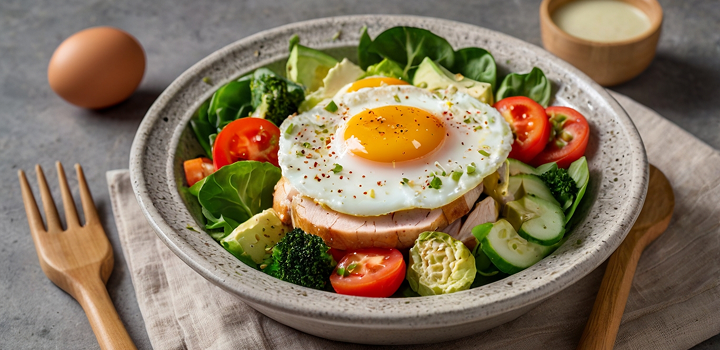
Protein for Sustained Energy
I’ve cooked professionally for years, and if there’s one thing I’ve come to appreciate early in the day, it’s a breakfast that doesn’t just fill—but fuels. Chicken and egg breakfast salad is my go-to when I want long-lasting energy without the crash of sugar-heavy breakfasts. Chicken breast delivers lean, complete protein that stabilizes blood sugar, while eggs offer healthy fats and amino acids your body needs to function from morning into afternoon.
Unlike heavier dishes like chicken and waffles, which are delicious but best saved for a weekend brunch, this salad keeps things clean and functional. A bowl of fresh greens, tender chicken, and eggs with a light yogurt-based dressing is enough to power a full shift in the kitchen or a focused day at a desk. No sluggishness, just slow-release fuel.
Light Yet Satisfying Meal
When I talk to people new to savory breakfasts, they often imagine something greasy or dense. This salad proves otherwise. It’s light enough not to weigh you down, but packed with flavor and texture. Crisp vegetables bring volume without excess calories. The creamy yogurt dressing coats the chicken and eggs without smothering the ingredients. It’s a dish that satisfies hunger while still feeling fresh.
This approach reminds me of how I balance flavors in something like a chicken burrito, where everything must work in harmony—protein, acid, fat, and crunch. The same rules apply here, just with cleaner ingredients and a colder format.
Key Ingredients Breakdown
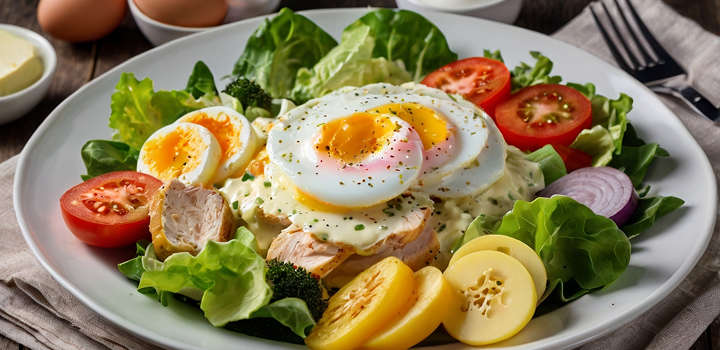
Chicken Breast Options
Grilled vs Poached vs Rotisserie
The heart of this salad is chicken, and how you prepare it will define the flavor and texture of the whole bowl. When I have time, I prefer to grill chicken breast. I marinate it lightly in lemon juice, olive oil, garlic, and herbs for 30 minutes, then grill until just cooked through and juicy. This gives the meat a slight char and adds smokiness.
For a softer bite, I poach chicken breasts in a simple broth of water, salt, bay leaf, and a few peppercorns. I bring the liquid to a gentle simmer and let the breasts cook low and slow, around 12 minutes, then rest them in the broth before slicing. Poaching yields the most tender, neutral-flavored chicken and is ideal if you want the salad’s dressing and vegetables to shine.
Rotisserie chicken, on the other hand, is a great shortcut. I often shred the breast meat from a store-bought rotisserie, especially if I’m making multiple portions ahead. It’s slightly saltier and more seasoned, which can work beautifully with the tang of yogurt and the richness of the egg.
Chicken Preparation Comparison Table
| Method | Texture | Prep Time | Flavor Intensity | Best For |
| Grilled | Firm, smoky | 30–40 min | High | Warm-weather, hearty bowls |
| Poached | Tender, clean | 15–20 min | Mild | Light, balanced salads |
| Rotisserie | Shredded, savory | 5 min | Medium-High | Quick prep, meal planning |
Eggs: Boiled, Sliced, or Chopped
Eggs give this salad richness and structure. I always start with hard-boiled eggs—cooked for 9 minutes, then cooled in ice water for a clean peel. I avoid overcooking them; gray-ringed yolks not only look unappetizing but taste sulfurous.
How I cut the egg depends on the salad’s other elements. For more composed, elegant bowls, I slice them into halves or quarters and lay them on top. For heartier, stir-together salads, I rough-chop the eggs so the yolk mixes with the dressing slightly, adding natural creaminess.
If I want to get playful, I’ll use jammy eggs cooked to about 7 minutes for a soft center—though I reserve this style more for plated breakfasts or open-face toast situations, like chicken and egg sandwich riffs, rather than cold-prepped salads.
Yogurt-Based Dressing
Greek vs Plain Yogurt
Dressing can make or break a breakfast salad. For mine, I always use yogurt as the base—it brings tang, creaminess, and nutrition. Greek yogurt makes the dressing thicker and higher in protein, while plain yogurt gives a lighter texture and milder flavor. If I’m packing the salad to go or prepping it the night before, I stick with Greek—it holds up better and doesn’t water out as quickly.
I use full-fat or 2% yogurt for flavor and body. Non-fat yogurt tends to be chalky and lacks the roundness needed to balance the acidity of lemon or vinegar in the mix.
Flavor Enhancers: Lemon, Dijon, Herbs
To the yogurt, I add fresh lemon juice or apple cider vinegar for acidity. I whisk in a spoonful of Dijon mustard, a splash of olive oil, salt, cracked pepper, and finely chopped herbs like dill, chives, or parsley. Sometimes I include a pinch of garlic powder or a dab of honey if the chicken is heavily seasoned.
The goal is balance: tangy but not sharp, creamy without feeling heavy, and herbaceous enough to brighten the dish. I make it in a small bowl and taste with a piece of plain chicken to test seasoning—this ensures it complements rather than overpowers.
Vegetable Additions
Leafy Greens vs Crunchy Veggies
I build most bowls on a base of fresh greens—baby spinach, arugula, or a spring mix. These offer a soft contrast to the meat and eggs. When I want crunch, I add shredded cabbage, sliced radishes, or cucumbers. They hold their shape better if you’re packing lunch or prepping for the week.
I keep watery vegetables like tomatoes or bell peppers to a minimum unless I’m serving the salad immediately. Otherwise, they release juice and dilute the dressing.
Fruits, Nuts, Seeds for Texture
To add dimension, I sometimes include thin apple slices, roasted sunflower seeds, or a handful of crushed walnuts. These small touches add texture and keep the salad from tasting monotonous. Dried cranberries or pomegranate seeds also work, especially if you lean sweeter with the dressing.
The key is not to overload. One fruit, one nut or seed, and one green or crunchy vegetable is enough to make the bowl feel varied but cohesive.
Making the Perfect Salad Bowl
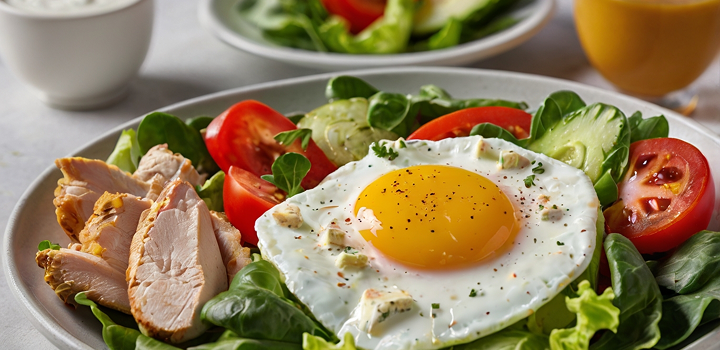
Prep and Cook Chicken Efficiently
Efficiency in the kitchen doesn’t mean rushing—it means reducing friction. I always prep chicken breasts in batches at the start of the week. If I grill, I marinate three or four fillets at once with oil, lemon, garlic, and dried herbs. I sear them on a grill pan, let them rest, then chill and slice them thinly for use over several days. Each portion goes into its own container so I can build bowls in minutes.
Poaching is even easier. I simmer several breasts at once in salted water with a bay leaf. Once they reach 160°F internally, I turn off the heat and let them cool in the liquid. This not only keeps them juicy, it allows me to use the poaching liquid later as broth for soups or grain cooking. When pressed for time, I shred rotisserie chicken into small pieces and store it plain to avoid sogginess once dressing is added.
What matters is that the chicken is fully cooled before it goes into the salad. Warm meat wilts greens and breaks emulsions in yogurt dressings. I use a clean, dry board to slice, and I cut across the grain to make each bite tender.
Perfecting Hard-Boiled Eggs
Boiling an egg isn’t just a task—it’s a ritual. I bring water to a boil, lower the eggs gently, and set a timer for 9 minutes. Immediately after, I transfer them to an ice bath. This locks the yolk into a rich, bright yellow and stops the sulfur reaction that creates that gray outer ring.
Peeling is easiest when the eggs are at least a few days old. If I need perfect halves for plating, I peel under water and use a damp, thin-blade knife to slice. For chopped eggs, I use a fork to break them gently so the yolks crumble into soft bits that catch the dressing without overpowering it.
Timing, chilling, and gentle handling—these three things are what separate rubbery eggs from creamy, delicate centers that work in harmony with greens and protein.
Crafting a Balanced Yogurt Dressing
Yogurt dressing is more sensitive than oil-based vinaigrettes. I whisk it gently in a cold bowl to avoid splitting. A thick yogurt base—Greek or strained—helps it cling to chicken and egg pieces rather than sliding off or pooling at the bottom.
For ratio, I use two parts yogurt, one part acid (lemon juice or apple cider vinegar), a half-part olive oil, a spoon of Dijon mustard, and finely chopped herbs. If the yogurt is too tangy, I soften it with a teaspoon of honey. If it’s too bland, I add sea salt or even a touch of garlic powder.
Once mixed, I taste the dressing on a bit of lettuce or protein—not with a spoon—because it’s the interaction with the food that tells you if it’s balanced. If it feels sharp, I add a drop more oil. If it feels flat, I brighten it with a squeeze of lemon.
Assembly Tips for Color, Texture, and Flavor
When I build the salad, I start with a wide, shallow bowl. I layer my greens first—usually arugula or baby spinach—and then add proteins and vegetables in a way that shows contrast and variety. Bright egg halves, slices of grilled chicken, red radish or purple cabbage, a scatter of nuts or seeds, and a drizzle of pale dressing—it all creates visual and textural interest.
I don’t mix everything until just before serving. I spoon dressing into the base of the bowl, toss greens lightly first, then layer the heavier ingredients on top. This preserves structure. Only if serving immediately do I toss everything together—gently, with my hands or a large spoon.
For packed lunches, I keep dressing in a separate container and combine just before eating. For meal prep, I assemble three salads at once, varying the garnishes slightly to keep the meals interesting throughout the week.
Rationale & SEO Alignment
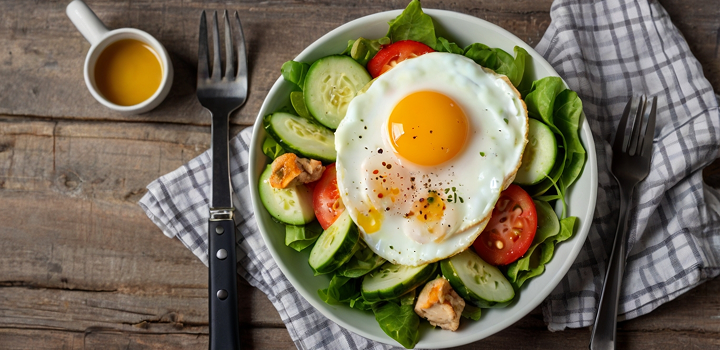
Protein-Focused Headings
This article is structured to directly address high-volume search queries around “protein breakfast salad,” “chicken egg salad for breakfast,” and “healthy protein bowls.” The clear, repeated emphasis on chicken breast, boiled eggs, and yogurt makes the content visible to users looking for performance-fueling meals and macro-friendly meal prep.
These elements also support internal navigation and allow natural linking to articles like chicken and egg sandwich, which share overlapping ingredients but different formats.
Dressing Detail
Many competing articles gloss over the yogurt dressing. Here, I provide exact ratios, consistency adjustments, and flavor balancing guidance. This ensures users searching “Greek yogurt chicken salad dressing” or “healthy breakfast dressing” find relevant, actionable content—not just a list of ingredients.
Make-Ahead Tips
By including real-world prep advice—batch cooking chicken, proper egg storage, portable assembly—this article taps into the strong “meal prep for breakfast” segment. Users planning weekly meals or lunchboxes will find clear answers here, with an edge over standard recipes.
Veggie and Texture Focus
Rather than listing vegetables, the article explains why and how to balance soft proteins with crisp or juicy textures. This depth supports keyphrases like “crunchy salad breakfast,” “vegetables in chicken salad,” and “what to put in breakfast bowls.” It also mirrors the balance found in meals like chicken burrito bowls but delivers it in a lighter, salad-based form.
Variations and Dietary Tweaks
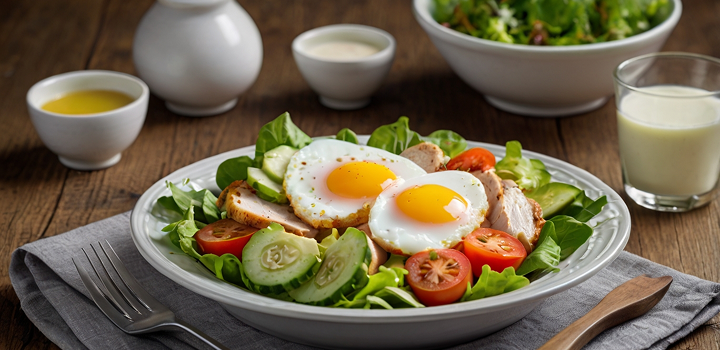
Low-Carb and Keto-Friendly Versions
When I’m cooking for someone on a low-carb or keto regimen, I adjust the salad by removing starchy vegetables and fruit. I stick to high-fat toppings and proteins, using full-fat Greek yogurt, avocado slices, and extra olive oil in the dressing. Chicken thighs, rather than breast, give more richness and satiety. For greens, I favor arugula, kale, or butter lettuce because they hold up well and pair naturally with creamy dressings.
In keto builds, I completely skip sweet elements like honey or fruit. Instead, I sharpen the flavor with capers, olives, or a dash of grainy mustard. Chopped boiled eggs and shredded rotisserie chicken combine into something close to a deconstructed chicken and egg sandwich, minus the carbs.
Dairy-Free & Vegan-Adaptable Dressings
While this is a chicken and egg salad at its core, I’ve had guests request dairy-free dressings or vegetarian variants. To adapt the yogurt base, I use coconut yogurt or cashew cream. Both are neutral enough to accept lemon juice, garlic, and mustard, though they behave differently when mixed. Cashew cream is thicker and needs thinning; coconut yogurt may need extra acid to balance its subtle sweetness.
For vegan versions, I omit the eggs and substitute the chicken with baked tofu or roasted chickpeas. These offer texture and protein without relying on animal products. The dressing must be tasted carefully—non-dairy yogurts can vary widely, and herbs become even more important to keep the flavor vibrant.
This also opens the door for warm grain bowls built around the same idea—something close in spirit to a chicken burrito, but redesigned for plant-based eaters.
Meal-Prep & Make-Ahead Strategies
When I prepare this salad for the week ahead, I start with component separation. I store cooked chicken, boiled eggs, and washed greens in individual containers. The yogurt dressing goes in a small glass jar with a tight lid, and I always label the date. These pieces last 4–5 days refrigerated if kept dry and untouched by dressing.
The only element I avoid prepping too early is anything with high water content—cucumbers, tomatoes, or citrus-dressed vegetables. They release liquid that can turn the greens soggy.
For maximum freshness, I assemble portions the night before and add the dressing in the morning. When packing lunch, I layer heartier ingredients (like chicken and cabbage) at the bottom of the container, place eggs and greens on top, and keep the dressing separate. This layering keeps the greens crisp until it’s time to eat.
15+ Frequently Asked Questions
1. Can I make this salad the night before?
Yes, I often prep it in the evening. Just keep the dressing separate and store the salad in an airtight container in the fridge. Add the dressing right before eating to preserve the texture.
2. How long do boiled eggs last in the fridge?
Hard-boiled eggs last up to 7 days if peeled and stored dry in a sealed container. I avoid storing them with wet greens to prevent sliminess.
3. Is Greek yogurt dressing safe to leave out for lunch?
If kept cool in an insulated lunchbox or fridge, it’s perfectly safe for 4–6 hours. Otherwise, I recommend using plant-based dressings that are less temperature-sensitive.
4. Can I freeze cooked chicken for salads?
Yes, but only if it’s grilled or roasted. Poached chicken can turn mushy after freezing. I freeze in thin slices and thaw overnight in the fridge.
5. What’s the best way to peel eggs cleanly?
Use eggs that are 5–7 days old, boil them for 9 minutes, then plunge into ice water. Roll gently on the counter to crack the shell, and peel under running water.
6. What kind of mustard works best in the dressing?
Dijon adds smooth tang. For more texture, I use whole-grain mustard. Avoid yellow mustard—it overpowers the yogurt and turns the dressing too sharp.
7. Can I add cheese to this salad?
Yes, crumbled feta or shaved parmesan work well. I avoid soft cheeses like brie or mozzarella—they don’t mix well with the dressing’s acidity.
8. How do I keep greens from wilting?
Dry them completely after washing, use a salad spinner, and never store with dressing. Greens wilt faster when exposed to moisture or salt.
9. Is this salad good for weight loss?
Absolutely. It’s high in protein and fiber, low in sugar, and customizable for low-calorie or low-carb needs. The yogurt dressing also adds probiotics.
10. What herbs go best in the dressing?
I use dill, parsley, or chives most often. Basil and cilantro work too, especially with lemon. Avoid rosemary or thyme—they’re too woody and overpowering.
11. Can I add grains like quinoa or farro?
Yes, for a more filling bowl, I layer in cooked grains under the greens. Just cool them completely before assembling the salad to avoid wilting.
12. How can I reduce prep time on busy mornings?
Cook the chicken and eggs in advance. Store greens washed and dried. Make dressing in batches and refrigerate. In the morning, assembly takes under 5 minutes.
13. What’s the best chicken cut for quick prep?
Thin-sliced boneless breast or rotisserie meat. They’re fast to cook and easy to portion. I avoid bone-in cuts unless I’m batch-roasting ahead.
14. Can I substitute the egg with something else?
If you’re avoiding eggs, try avocado slices or grilled tofu. They provide a similar creamy texture and balance the salad’s protein-fat ratio.
15. How can I make this salad more kid-friendly?
I cut everything small, use a milder yogurt dressing (without mustard), and add fun elements like chopped apple or cheese cubes to make it appealing.

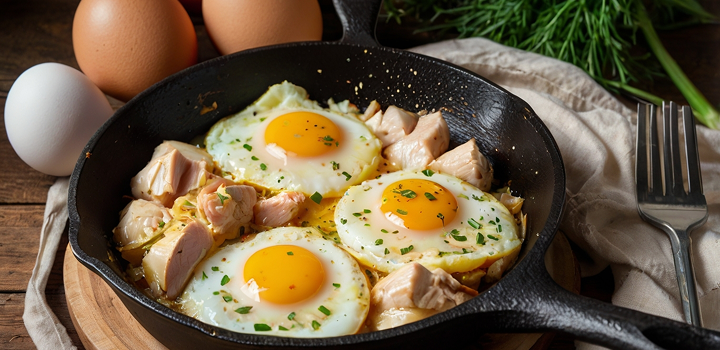
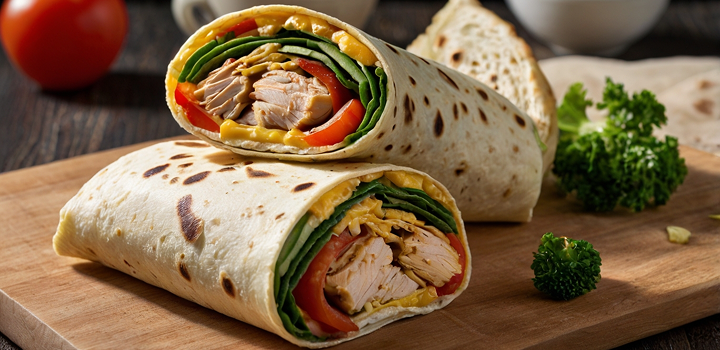


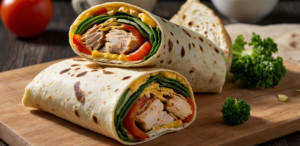
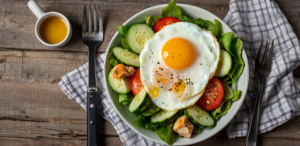




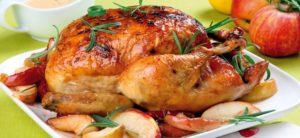

Post Comment